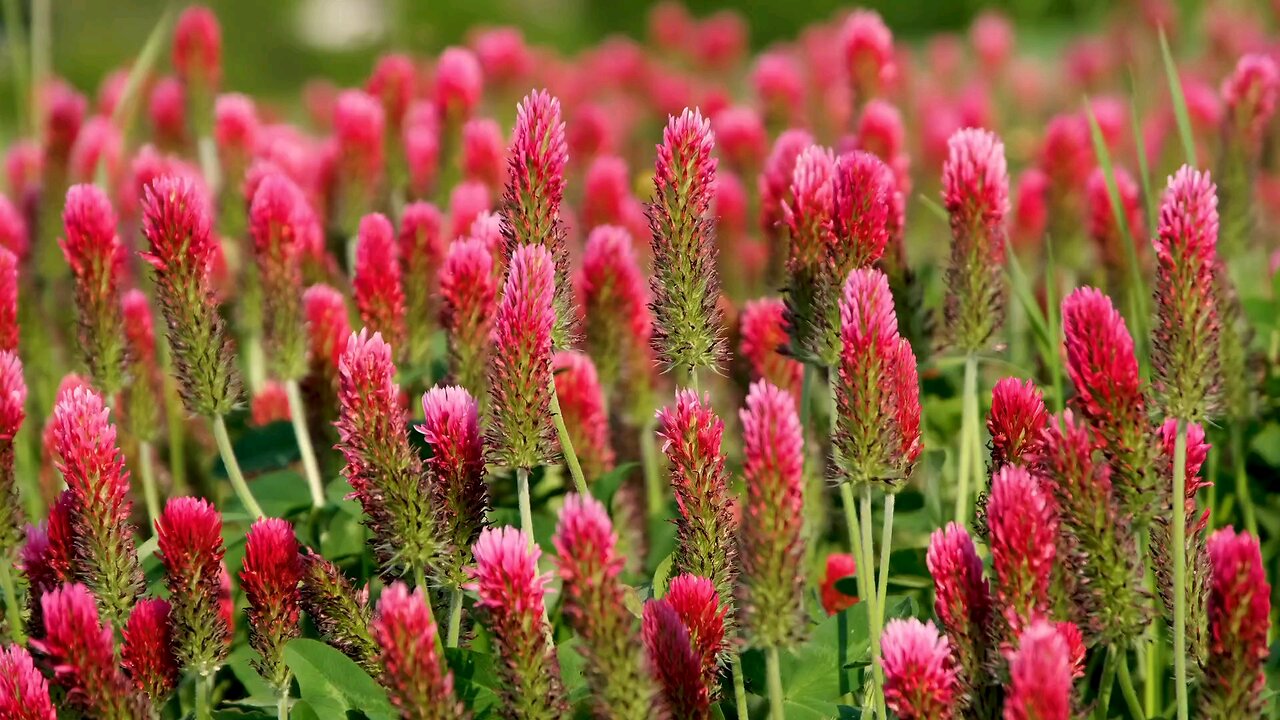Premium Only Content

"Red Clover (Trifolium pratense): Vibrant Blooms and Benefits"
Red clover (Trifolium pratense) is a perennial herbaceous plant belonging to the legume family (Fabaceae). It is native to Europe, Western Asia, and northwest Africa but has been widely naturalized in many other regions, including North America.
### Characteristics
- **Appearance**: Red clover has a characteristic pinkish-red flower head composed of numerous small, tubular florets. Its leaves are trifoliate, meaning they have three leaflets, often with a pale, crescent-shaped mark.
- **Growth**: It typically grows to a height of 20-80 cm and thrives in a variety of soils, especially well-drained, loamy soils. Red clover is often found in fields, meadows, and along roadsides.
- **Lifecycle**: It is a short-lived perennial, often surviving for 2-3 years.
### Uses
- **Agricultural**:
- **Forage Crop**: Widely used as livestock fodder due to its high protein content and palatability.
- **Cover Crop**: Helps in soil improvement and management, as it fixes nitrogen, improving soil fertility.
- **Crop Rotation**: Used in crop rotation systems to reduce soil erosion and improve soil structure.
- **Medicinal**: Red clover is known for its phytoestrogens, which are compounds that mimic estrogen in the body. It is used in traditional medicine for:
- **Menopausal Symptoms**: Alleviating hot flashes and other menopausal symptoms.
- **Skin Health**: Treating skin conditions like eczema and psoriasis.
- **Cardiovascular Health**: Supporting heart health by improving circulation and reducing blood pressure.
- **Culinary**: Though less common, the flowers and leaves can be used in salads or as a garnish. They are also sometimes used to make herbal teas.
### Environmental Benefits
- **Biodiversity**: Red clover provides a habitat and food source for various pollinators, including bees and butterflies.
- **Soil Health**: Enhances soil structure and fertility through nitrogen fixation and organic matter addition.
### Cultivation
- **Planting**: It is usually sown in early spring or late summer. It requires adequate sunlight and moderate watering.
- **Maintenance**: Minimal maintenance is required once established, but periodic mowing can encourage denser growth.
### Challenges
- **Pests and Diseases**: Susceptible to root rot, powdery mildew, and various pests like aphids.
- **Invasiveness**: While beneficial, it can sometimes become invasive in non-native regions, outcompeting local flora.
Overall, red clover is a versatile and valuable plant in agriculture, medicine, and environmental management.
-
 4:41:07
4:41:07
Nerdrotic
9 hours ago $28.17 earnedCap 4 and Emelia Perez BACKLASH! Acolyte is Still CANCELED! Hollywood STFU | Friday Night Tights 339
169K27 -
 57:41
57:41
The StoneZONE with Roger Stone
6 hours agoWhy Are They So Afraid of Tulsi Gabbard? | The StoneZONE w/ Roger Stone
34K7 -
 LIVE
LIVE
I_Came_With_Fire_Podcast
10 hours ago🔥🔥Suing CHINA, Hillary AIDED RUSSIA, and DEI REMOVED from Military🔥🔥
1,478 watching -
 LIVE
LIVE
SoniCentric
11 hours agoCozy Up With SNOWY Lakeside Cabin Jazz Vibes
120 watching -
 1:36:16
1:36:16
PMG
1 day ago $0.27 earnedSPECIAL: JUSTICE FOR JEREMY - NOW!
12.7K3 -
 1:01:01
1:01:01
TheTapeLibrary
14 hours ago $2.09 earnedThe Horrifying True Story of Summerwind Mansion
26.3K4 -
 29:28
29:28
Afshin Rattansi's Going Underground
1 day agoMax Blumenthal on US’ Ukraine Aid Corruption, 'Psychotic' Israel Turning the West Bank into Gaza
34.3K4 -
 57:12
57:12
Flyover Conservatives
23 hours agoCovid, Control, & Corruption —Dr. Stella Immanuel’s Plan to BEAT the System! | FOC Show
21.8K -
 57:13
57:13
Sarah Westall
6 hours agoUnited States in a Two Front War, Identify Military Psyops and Special Operations w/ Jeffrey Prather
62K10 -
 2:14:05
2:14:05
Quite Frankly
10 hours ago"Open Phones: Philly & D.C. Crashes" 1/31/25
47.2K18